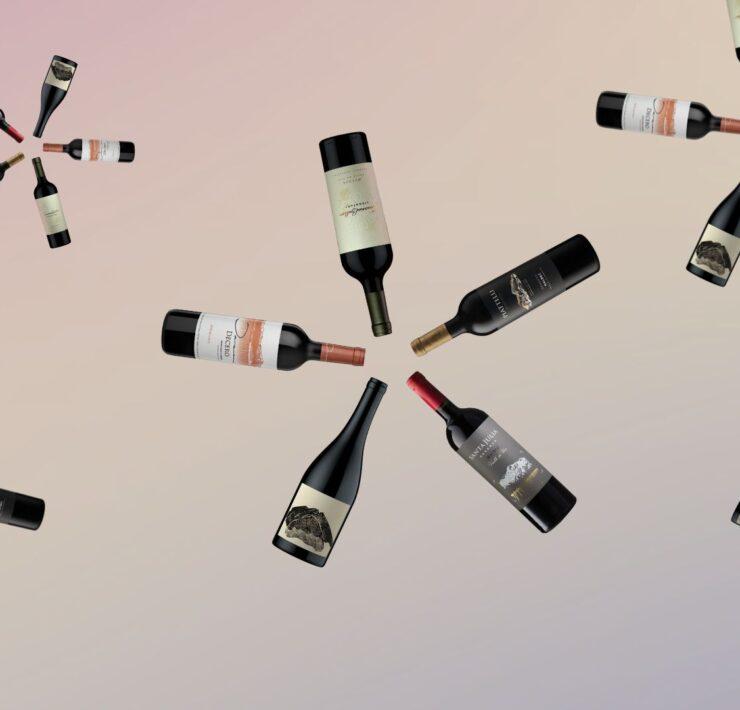With early experiences that traverse iconic wineries like Simi and Opus One, it’s no surprise that Paul Hobbs became one of the country’s most proficient winemakers. However, his curiosity and exploratory drive have taken him on a wine journey well beyond what anyone could imagine.
Born and raised in upstate New York, Hobbs developed an early fascination with agriculture, exploring the fields and orchards surrounding his family’s farm. These formative years would lead him down a path as one of the most influential winemakers of his generation.
For nearly three decades, Hobbs has been growing his global portfolio, which now includes seven wineries across four continents. Beyond his national wineries in Finger Lakes, New York, and Sebastopol, California, he’s an international winemaker, a true visionary, in places like Cahors (Crocus), Galicia (Alvaredos-Hobbs), and Armenia (Yacoubian-Hobbs).
“Culturally, I find it extremely interesting,” Hobbs says, specifically about what drew him to a partnership in Armenia. Hobbs produces an Areni, which is featured in the latest SOMM film, Cup of Salvation, and is seeing firsthand the region’s recent surge in popularity. “The industry in Armenia was just beginning its reawakening [in 2014], and I always like to be on the ground floor.”
Of course, this isn’t the first time Hobbs has been at the forefront of a varietal tidal wave. In the late 1980s and early 1990s, Hobbs found himself in Mendoza, armed with a pioneering spirit and a hardy tool belt of expertise. His visionary approach earned him widespread acclaim, cementing his legacy as a Malbec trailblazer and eventually creating his Viña Cobos label in 1998, which now exports to over 70 countries.
Here, we chat about how it all started and how his unwavering commitment to quality has made him a true icon of the wine industry.
Note: This interview has been edited for clarity and length.
Nicole MacKay: You’ve mentioned previously that Chile, not Argentina, was your initial draw to South American winemaking. What was it about the Chilean terroir that piqued your interest?
Paul Hobbs: Well, we’re talking about the mid-eighties, and during that period, some pundits argued that Chile perhaps had a superior climate even to California. There was a lot of interest brewing with Chile. I was in a situation in my professional career where I was looking to strike out on my own. And so, it seemed logical that Chile would be a place to visit and to understand if there were opportunities. So that’s why I made that visit in March of ’88.
NM: That visit led you over the mountains to Mendoza. What were your expectations?
PH: Let me start with Chile. I visited several producers over nearly a week and was disappointed by the farming. I felt their focus was more on quantity than quality. Santa Rita and Ignacio [Recabarren] was the exception. Many producers had large tanks and large production vineyards on pretty uninspiring valley floor soils, so Chile didn’t blow me away.
Argentina’s reputation was so poor that I thought visiting would be a waste of time. I was very resistant. But I finally relented. As we got to Mendoza, the quality of the soils and the high-density plantings were impressive. Both situations were superior to anything I’d seen in Chile, which immediately piqued my interest.
I got out of the car, looked at the vineyard, and didn’t recognize the grape variety, but it turned out to be Malbec. It was my first experience with the grape, and of course, this is March. So, it was just days before they were going to harvest. It couldn’t have been better timing.
The vineyards were well managed in appearance, but there was room for improvement. They were over-irrigated, and the fruit was being cocooned inside shoots, and so on.
After that, we drove to Catena’s winery in the east, which was a premium winery. I met all the core Catena people, which was great, but the winery was abominable in many ways. There was equipment there that I wouldn’t expect to find in a French museum. Frankly, I didn’t have any historical background; I didn’t know they were isolationists.
I met with Nicolas Catena the next day, and he told me what he wanted to do, which aligned with what I wanted to do: start my own project. So we decided to join forces; I would help him, and he would help me. I began consulting with Nicolas in 1989, and then he became an investor and helped me form Paul Hobbs Winery in 1991.
NM: There is essentially a decade span between your initial visit and your first Malbec release under your Viña Cobos label. What were you doing to improve the viticulture and processes to prepare for a brand of your own?
PH: Well, I was consulting at a very high level; I was wedded to [Catena’s] program and would spend up to six months of the year there on multiple trips. I had a lot to learn about Mendoza and the culture so I could interact with the people. There was a learning curve for me in every aspect: learning their business, understanding what Catena wanted to do, and trying to figure out ways to make that happen.
I would spend the mornings in the vineyard, and in the afternoons, after lunch, I would be in the winery. We worked on irrigation, fertilization, and canopy management. Fortunately, we didn’t have to re-plant; they had done that well, with high-density planting and some very good soils. They had already done the hard part — the part that you can’t change.
So, the big question was, where and what could we do? Catena wanted quality, so we started looking at higher elevations. That drove us up into a brand new region: Valle de Uco. Nobody really talked about it; only a handful of vineyards were up there. Most viticulturists felt it was too cold for quality red varieties; grapes sold from that region mostly went into sparkling programs. That was one of the biggest things I pushed for to explore these higher-elevation regions of Mendoza.
So I convinced Catena to plant a vineyard up there: 30 hectares for $1,000 per hectare. And that began a gold rush. It was literally a pile-on. We planted in 1992, which created a competition with Chandon. So Chandon went out and planted a higher elevation vineyard and then it was like, ok, who’s, who’s gonna get to the highest? They still have a bit of that mentality.
With the winery, fortunately, the timing was good because Argentina ended its isolationist political environment right around 1990. We could then import quality equipment from Europe. Making competitive wines on the international market was difficult without better bottling equipment. We couldn’t bottle wine without oxidizing it with our old, ancient equipment.
NM: The messaging on the Viña Cobos website focuses a lot on farming and terroir integrity but not specifically on sustainable or organic certifications. What’s the mindset behind that?
PH: I find organic certification to be a bit of a farce, at least in Argentina. I’ve consulted with some of the wineries there that are organic certified and even have USDA certification. I don’t know how that works because when you walk the venue and see what’s happening, I don’t feel good about [what I see].
We’d rather walk than talk. When people come to see us first, then you go to see any other vineyard, it will stick in their heads. For example, our vineyard in Los Árboles is called Chañares, and it’s a leading vineyard anywhere in South America in terms of how it’s being farmed. We don’t till, we don’t use herbicide. I love going there.
We are very dedicated to sustainability. Most of our farming is entirely organic, but certification ties you up into one school of thought, and I’ve never believed in handcuffing myself to one school of thought and one person’s way of thinking.

NM: That’s a great segue into evolution. What’s on your horizon for Malbec and Viña Cobos over the next five or ten years?
PH: Well, we’ve capped production levels because if you’re constantly growing in volume, that’s a different focus. So we’ve capped production at 150,000-160,000 cases. We could improve the winery in terms of various types of fermenters or equipment, but we have pretty much state-of-the-art equipment. The winery is very simple because we try to nurture the process rather than dominate the process.
We want to continue growing in quality and raise our price points. In that sense, we are in over 70 markets worldwide, including La Place de Bordeaux. So, we expect to enter with another wine in another year or two.
NM: Do you think Argentine Malbec has seen its peak in terms of the global market, or, to put it another way, should Argentina grow beyond Malbec on a worldwide stage?
PH: Clearly, we want to grow beyond Malbec. Argentina can do some very high-level work in Chardonnay and the Bordeaux varietals. I think it’s important for Argentina to have at least three varietals, like a tripod, some stability, and recognition — and certainly, in parts of the world, it is.
One of our roles, along with a handful of others, is to help create awareness that Argentina is more than Malbec.
We started very well in the early 90s, but then it became overly popular, so quality dipped badly, damaging its reputation. That’s stopped, and there’s good growth in the varietal, particularly if blended with a little Cabernet or Cabernet Franc; it can be very interesting even with small percentages of five or 10 percent. Malbec is a compelling variety in that sense. Frankly, I see a bright future for the grape.

NM: If you could pinpoint one thing, whether it’s a tangible physical skill or a part of your personality, that has led to your success as a winemaker, what would it be?
PH: I’m a very curious person, and I have a drive for quality. Through winemaking, I found my passion for detail because I really wanted to be a surgeon in my youth. It’s very specialized, and I like to do detailed work with my hands. So I have an obsession, you might say, with attention to detail, but in all areas. With organization, for example, I’m relentless in that area.
I also like different cultures and the learning that comes with them, and I like exploration. That’s one of the reasons I go to these regions that are either undiscovered altogether or have been discovered and fell into a black hole or something to that effect.
People once said it was too hot in Argentina to grow fine-quality wine grapes. I thought, how can it be too hot with the Andes right there? So maybe I was trying to prove others wrong. It’s fun if you can see a path that others don’t see.







